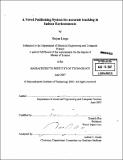| dc.contributor.advisor | Daniela Rus. | en_US |
| dc.contributor.author | Linga, Srujan | en_US |
| dc.contributor.other | Massachusetts Institute of Technology. Dept. of Electrical Engineering and Computer Science. | en_US |
| dc.date.accessioned | 2008-02-27T22:44:07Z | |
| dc.date.available | 2008-02-27T22:44:07Z | |
| dc.date.copyright | 2007 | en_US |
| dc.date.issued | 2007 | en_US |
| dc.identifier.uri | http://hdl.handle.net/1721.1/40530 | |
| dc.description | Thesis (S.M.)--Massachusetts Institute of Technology, Dept. of Electrical Engineering and Computer Science, 2007. | en_US |
| dc.description | Includes bibliographical references (p. 91-93). | en_US |
| dc.description.abstract | Precise positioning is crucial to many applications involving autonomous robots in indoor environments. Current solutions to the indoor localization problem are either both highly unreliable and inaccurate (like GPS based systems), or hugely expensive (such as the iGPS system). In this thesis we propose, design and build a low-cost, robust and highly accurate indoor localization system using laser light sources. The system is composed of three transmitting laser modules arranged in a straight line and a receiver module mounted on the mobile robot. The system calculates the coordinates of the mobile robot by using triangulation algorithms which require precisely measured values of the angles of the receiver with respect to the three laser emitters. Results from practical testing of the system in an aircraft wing assembly set-up have been found to be extremely encouraging. Using our system, the mobile robotic arm could be localized accurately within error margins defined approximately by Gaussian distributions centered at the object's true coordinate values and with standard deviations of 0.1778 mm, 0.1016 mm and 0.3352 mm in the x, y and z coordinate directions respectively. The system is also used to detect height drop in the arm due to its weight as it extends to perform fitting operations on the skin of the wing. Feedback from the laser localization system is used to adjust the position of the tip of the robotic arm in order to perform a sequence of high precision docking tasks within the aircraft wing. | en_US |
| dc.description.statementofresponsibility | by Srujan Linga. | en_US |
| dc.format.extent | 93 p. | en_US |
| dc.language.iso | eng | en_US |
| dc.publisher | Massachusetts Institute of Technology | en_US |
| dc.rights | M.I.T. theses are protected by copyright. They may be viewed from this source for any purpose, but reproduction or distribution in any format is prohibited without written permission. See provided URL for inquiries about permission. | en_US |
| dc.rights.uri | http://dspace.mit.edu/handle/1721.1/7582 | |
| dc.subject | Electrical Engineering and Computer Science. | en_US |
| dc.title | A novel positioning system for accurate tracking in indoor environments | en_US |
| dc.type | Thesis | en_US |
| dc.description.degree | S.M. | en_US |
| dc.contributor.department | Massachusetts Institute of Technology. Department of Electrical Engineering and Computer Science | |
| dc.identifier.oclc | 191913758 | en_US |
